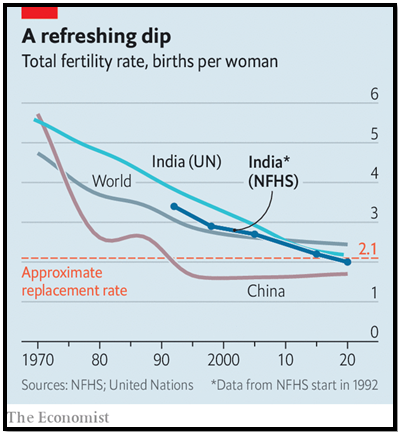POPULATION SHRINKAGE IS NOT A PROBLEM, BUT HUNGRY KIDS ARE
Syllabus:
- GS-2- Population issues and demographic dividend , solutions
Focus :
- The article focuses on the projected peak and subsequent decline of the global population, emphasizing the shift in priorities from population control to addressing child welfare issues. It highlights the need for policies that support reproductive freedom, improve child nutrition, education, and healthcare, and adapt to demographic changes for sustainable development.
Source - TET
Introduction: Shifting Population Trends
- Peak Population Projection:
- A recent study in the Lancet predicts the global population will peak at 9.5 billion by the early 2060s, much earlier than previously expected.
- This is a significant shift from the UN’s 2017 prediction that human numbers would peak at over 11 billion by 2100.
- Decline in Birth Rates:
- By 2030, global birth rates are expected to fall below replacement levels.
- Factors such as increased education for women and greater reproductive freedom are key contributors to this trend.
- Economic and Environmental Implications:
- There are concerns among economists and political leaders about the rising number of older people and declining workforce.
- Some environmentalists advocate for a faster decline in population to mitigate climate change and preserve habitats.
Different Terms :
|
Debating the Right Population Size
- Is 9.5 Billion Too Many or Too Few?:
- The debate centers around whether the projected peak population is sustainable or if it will lead to resource shortages.
- Questions arise about the optimal number of humans for maintaining a balance with the environment.
- Focusing on Child Welfare:
- Instead of fixating on population numbers, the focus should shift to ensuring all children receive adequate nutrition, education, and healthcare.
- Despite sufficient global food production, a significant portion of the population remains undernourished.
- Joel Cohen’s Perspective:
- Demographer Joel Cohen emphasizes that the “right number of people” depends on various factors such as material wealth standards and acceptable inequality levels.
- He supports the Lancet’s projection as a credible forecast of population trends.
Policy Implications and Recommendations
- Maximizing Reproductive Liberty:
- Policies should prioritize enabling individuals to have the number of children they desire, without external pressures.
- Education and access to contraception play critical roles in reducing fertility rates.
- Failures of Pronatalist Policies:
- Government efforts to boost birth rates through economic incentives or restrictive abortion laws have largely been ineffective.
- In the US, restrictive abortion laws may have inadvertently increased rates of voluntary sterilization.
- Impact of Reliable Contraception:
- Universal access to reliable, safe, and long-term contraception could significantly reduce unintended pregnancies and abortions.
- This would allow people to plan their families better and reduce the need for permanent sterilization.
Addressing Child Welfare
Current Child Hunger Statistics:
- Despite ample food production, 10% of the global population is chronically undernourished.
- Over 20% of children suffer from stunted growth due to chronic hunger and infections.
Improving Child Care Policies:
- Policies should focus on enhancing the nutrition, healthcare, and education available to children.
- Ensuring that existing children are well-cared for can prevent future socio-economic issues.
Ethical Considerations:
- Bioethicist Margaret Pabst Battin suggests a thought experiment where all pregnancies are planned through access to reliable contraception.
- This approach could reduce unplanned pregnancies and abortions, aligning birth rates more closely with personal and societal capacities.
Conclusion: Reframing the Population Debate
Gloom and Doom Narratives:
- Population trends are often portrayed as crises, whether it’s overpopulation or declining birth rates.
- Instead of focusing on these extremes, policies should aim to help people achieve their desired family sizes.
Future Policy Focus:
- Policymakers should work towards creating conditions that support children’s welfare, reproductive freedom, and sustainable population levels.
- Addressing current issues like child hunger and education will have long-term benefits for society.
Source:The Economic Times
Associated Article :
https://universalinstitutions.com/elderly-population-in-india/
Mains Practice Question :
GS-2
“Discuss the implications of the projected peak in global population at 9.5 billion by the early 2060s. Evaluate the challenges and opportunities associated with declining fertility rates and increasing aging populations. How should policies be adapted to address the needs of children and ensure sustainable development.”(250 words)





